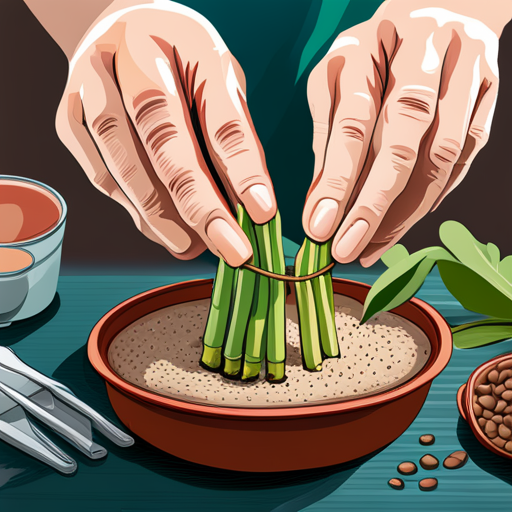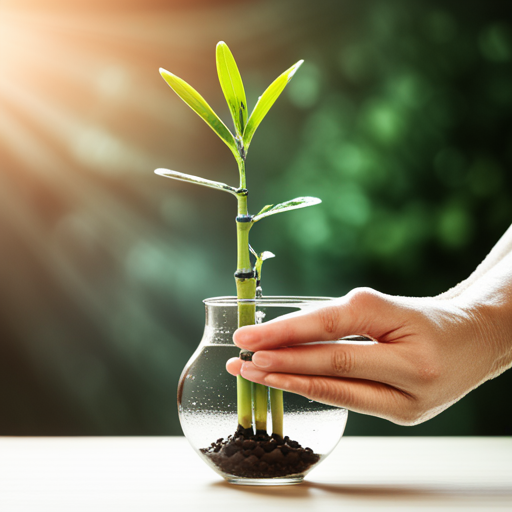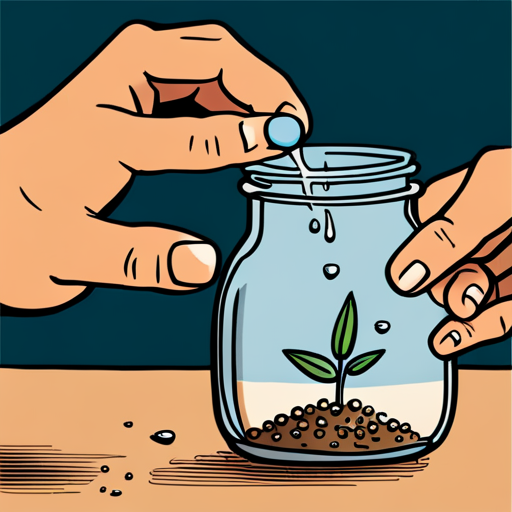Lucky bamboo, a popular aerial plant, can be grown from seeds with proper care and attention. This article provides a comprehensive guide on how to successfully grow lucky bamboo from seeds.
Starting with the collection of fresh bamboo seeds from a healthy source, the seeds are soaked in water and rinsed before being placed in a sunny location for germination. The optimal temperature range for lucky bamboo growth is between 65-75 degrees Fahrenheit.
Once the seeds have germinated, they are carefully transferred to a light organic soil mix. Regular watering is essential during the growing period. It is crucial to ensure the use of fresh seeds, provide adequate lighting, and maintain proper watering for successful germination and growth. Troubleshooting tips are also provided to address any issues that may arise.
Additionally, the article explores the option of purchasing lucky bamboo seeds for easier growth. Finally, the article discusses the process of transplanting the seedlings into larger pots or outdoor beds, along with the necessary care and maintenance required until they are ready for transplantation. Whether grown indoors or outdoors, this guide offers valuable insights for cultivating lucky bamboo from seeds.
Contents
- 1 Our Highlighted Points
- 2 Getting Started
- 3 Germination and Care
- 4 Transplanting and Maintenance
- 5 Can I Use Seeds to Propagate Lucky Bamboo?
- 6 Frequently Asked Questions
- 6.1 How long does it take for lucky bamboo seeds to germinate?
- 6.2 Can lucky bamboo be grown from cuttings instead of seeds?
- 6.3 What are some common pests or diseases that affect lucky bamboo plants?
- 6.4 How often should lucky bamboo plants be fertilized?
- 6.5 Can lucky bamboo be grown in hydroponic systems?
Our Highlighted Points
- Lucky bamboo can be grown from seeds collected from a healthy piece of bamboo in late winter or early spring.
- Soaking the seeds in water for 24 hours and placing them in a sunny location can help with germination.
- The optimal temperature range for lucky bamboo growth is between 65-75 degrees Fahrenheit.
– Regular watering and well-draining soil are important for the successful growth of lucky bamboo from seeds.
Getting Started

To begin growing lucky bamboo from seeds, fresh bamboo seeds should be collected from a healthy plant in late winter or early spring. The seeds should then be soaked in water for 24 hours. After soaking, the seeds should be placed in a sunny location for germination.
When it comes to choosing the right soil mix, lucky bamboo prefers a light organic soil mix that is well-draining. This will help prevent waterlogging and promote healthy root growth.
Additionally, providing adequate sunlight is crucial for successful germination and growth. Lucky bamboo thrives in a sunny location, with the optimal temperature range for growth being between 65-75 degrees Fahrenheit. Ensuring that the seeds receive enough sunlight will help stimulate germination and promote healthy seedling development.
Germination and Care

Germination of lucky bamboo seeds requires proper care and attention to ensure successful growth. Here are some tips for successful germination:
- Soak the seeds in water for 24 hours before planting to soften the outer shell and stimulate germination.
- Place the seeds in a sunny location with a temperature range of 65-75 degrees Fahrenheit for optimal growth.
- Use a light organic soil mix and plant the seeds on the surface, lightly covering them.
- Keep the soil moist but not soggy as the seeds germinate.
- Thin out the seedlings once they reach about 2 inches tall to allow only the strongest ones to grow.
Troubleshooting common germination issues:
- Ensure you are using fresh seeds, as older seeds may have a lower germination rate.
- Provide enough light for the seedlings to grow properly.
- Water the seedlings regularly, but avoid overwatering to prevent root rot.
By following these tips and troubleshooting common issues, you can increase the chances of successful germination and growth of lucky bamboo from seeds.
Transplanting and Maintenance

Transplanting and maintenance of lucky bamboo seedlings involve careful handling and regular care to ensure their successful growth. Once the seedlings have reached a sufficient size, they should be transplanted into larger pots or outdoor beds. This allows for their roots to spread and provides them with enough space to grow.
When transplanting, it is important to handle the seedlings gently, being cautious not to damage their delicate roots. Regular watering is crucial for the young plants to thrive, as they have higher water requirements. Additionally, fertilizing every few weeks will provide them with the necessary nutrients for healthy growth.
Pruning techniques can be employed to shape the lucky bamboo and maintain its desired appearance. It is important to be mindful of common pests and diseases that can affect lucky bamboo, such as spider mites and root rot. Regular monitoring and proper pest management strategies can help prevent and control these issues, ensuring the continued health and vitality of the lucky bamboo seedlings.
Can I Use Seeds to Propagate Lucky Bamboo?
Yes, you can use seeds as one of the propagating lucky bamboo methods. However, it is not the most common method, as lucky bamboo is typically propagated through cuttings or division. Seeds may take longer to grow and may not produce the same characteristics as the parent plant.
Frequently Asked Questions
How long does it take for lucky bamboo seeds to germinate?
The germination time for lucky bamboo seeds can vary, but it typically takes several weeks for the seeds to sprout. The ideal growing conditions for lucky bamboo include a temperature range of 65-75 degrees Fahrenheit and moist soil.
Can lucky bamboo be grown from cuttings instead of seeds?
Propagation methods of lucky bamboo include growing from cuttings. Advantages of this method include faster growth and the ability to replicate the parent plant. Disadvantages include the need for an established plant and the potential for disease transmission.
What are some common pests or diseases that affect lucky bamboo plants?
Common pests that affect lucky bamboo plants include spider mites, aphids, and mealybugs. Diseases like root rot and fungal infections can also occur. Prevention includes proper watering and hygiene. Natural remedies include neem oil and insecticidal soap.
How often should lucky bamboo plants be fertilized?
Lucky bamboo plants should be fertilized every two to four weeks during the growing season. Use a balanced liquid fertilizer or a slow-release granular fertilizer specifically formulated for houseplants.
Can lucky bamboo be grown in hydroponic systems?
Growing lucky bamboo in hydroponic systems offers several benefits. Hydroponic gardening provides a controlled environment for optimal growth, eliminates the need for soil, and allows for efficient nutrient uptake. Lucky bamboo can thrive in this system, resulting in healthy and vibrant plants.

